divedigger
Full Member
I will show you how I do it,step 1,find a relic
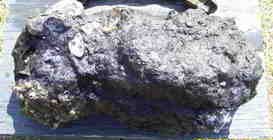 ,clean the rust cacoon off
,clean the rust cacoon off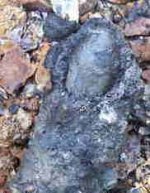 ,now your relic is clean
,now your relic is clean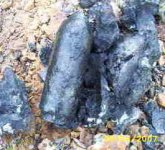 ,in this case powder had to be removed
,in this case powder had to be removed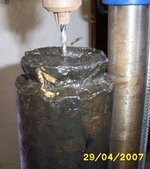 ,and flushed out
,and flushed out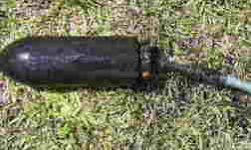 ,I tap mine for a good connection
,I tap mine for a good connection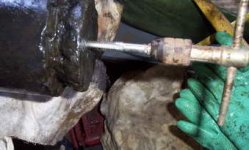 ,and hook up the ground wire with a ring connecter
,and hook up the ground wire with a ring connecter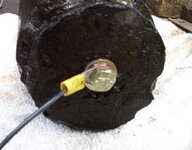 ,I set the relic on bricks in a tub
,I set the relic on bricks in a tub 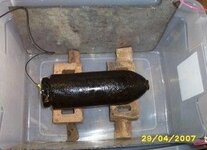 ,with steel or stainless anodes,hooking the positive lead of the power supply to the anodes,try to use low voltage,less than 6 volts,and low amperage,less than 1 if possible,cover with water,add a small amount of sodium hydroxide,big word for lye
,with steel or stainless anodes,hooking the positive lead of the power supply to the anodes,try to use low voltage,less than 6 volts,and low amperage,less than 1 if possible,cover with water,add a small amount of sodium hydroxide,big word for lye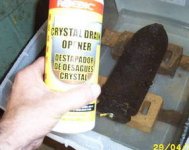 ,check for current
,check for current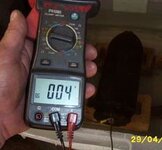 ,check the next day to see if any bubbles have formed on the surface,change water often,and be patient,this shell will cook for about 2 years.Pull it out when it's done and boil it in a turkey cooker with rainwater or distilled water,pour off water and pour in some cold water,do this 3-10 times.The last boil you can do a salt test,if good do the boil and pour off the water,let the heat of the shell help to dry it.Dry for a few days,clean with scotchbrite and coat with 2 coats of gloss polyurethane and then 2 coats of satin polyurethane.Let dry,take in house and show your friends.
,check the next day to see if any bubbles have formed on the surface,change water often,and be patient,this shell will cook for about 2 years.Pull it out when it's done and boil it in a turkey cooker with rainwater or distilled water,pour off water and pour in some cold water,do this 3-10 times.The last boil you can do a salt test,if good do the boil and pour off the water,let the heat of the shell help to dry it.Dry for a few days,clean with scotchbrite and coat with 2 coats of gloss polyurethane and then 2 coats of satin polyurethane.Let dry,take in house and show your friends.
 ,clean the rust cacoon off
,clean the rust cacoon off ,now your relic is clean
,now your relic is clean ,in this case powder had to be removed
,in this case powder had to be removed ,and flushed out
,and flushed out ,I tap mine for a good connection
,I tap mine for a good connection ,and hook up the ground wire with a ring connecter
,and hook up the ground wire with a ring connecter ,I set the relic on bricks in a tub
,I set the relic on bricks in a tub  ,with steel or stainless anodes,hooking the positive lead of the power supply to the anodes,try to use low voltage,less than 6 volts,and low amperage,less than 1 if possible,cover with water,add a small amount of sodium hydroxide,big word for lye
,with steel or stainless anodes,hooking the positive lead of the power supply to the anodes,try to use low voltage,less than 6 volts,and low amperage,less than 1 if possible,cover with water,add a small amount of sodium hydroxide,big word for lye ,check for current
,check for current ,check the next day to see if any bubbles have formed on the surface,change water often,and be patient,this shell will cook for about 2 years.Pull it out when it's done and boil it in a turkey cooker with rainwater or distilled water,pour off water and pour in some cold water,do this 3-10 times.The last boil you can do a salt test,if good do the boil and pour off the water,let the heat of the shell help to dry it.Dry for a few days,clean with scotchbrite and coat with 2 coats of gloss polyurethane and then 2 coats of satin polyurethane.Let dry,take in house and show your friends.
,check the next day to see if any bubbles have formed on the surface,change water often,and be patient,this shell will cook for about 2 years.Pull it out when it's done and boil it in a turkey cooker with rainwater or distilled water,pour off water and pour in some cold water,do this 3-10 times.The last boil you can do a salt test,if good do the boil and pour off the water,let the heat of the shell help to dry it.Dry for a few days,clean with scotchbrite and coat with 2 coats of gloss polyurethane and then 2 coats of satin polyurethane.Let dry,take in house and show your friends.



